OCZ Vertex 4 Review (256GB, 512GB)
by Anand Lal Shimpi on April 4, 2012 9:00 AM ESTSequential Read/Write Speed
To measure sequential performance I ran a 1 minute long 128KB sequential test over the entire span of the drive at a queue depth of 1. The results reported are in average MB/s over the entire test length.
As impressive as the random read/write speeds were, at low queue depths the Vertex 4's sequential read speed is problematic:

Curious as to what's going on, I ran AS-SSD and came away with much better results:
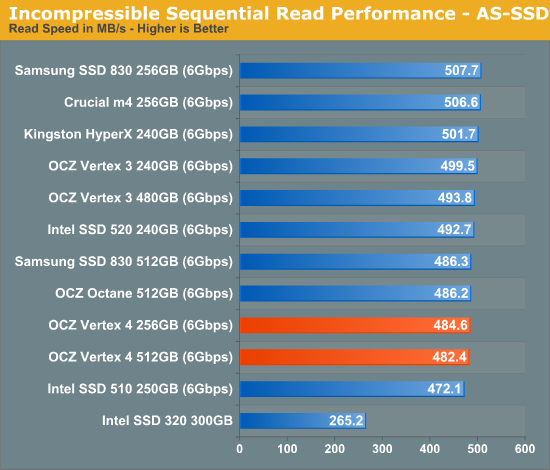
Finally I turn to ATTO, giving me the answer I'm looking for. The Vertex 4's sequential read speed is slow at low queue depths with certain workloads, move to larger transfer sizes or high queue depths and the problem resolves itself:
The problem is that many sequential read operations for client workloads occur at 64 – 128KB transfer sizes, and at a queue depth of 1 - 3. Looking at the ATTO data above you'll see that this is exactly the weak point of the Vertex 4.
I went back to Iometer and varied queue depth with our 128KB sequential read test and got a good characterization of the Vertex 4's large block, sequential read performance:
The Vertex 4 performs better with heavier workloads. While other drives extract enough parallelism to deliver fairly high performance with only a single IO in the queue, the Vertex 4 needs 2 or more for large block sequential reads. Heavier read workloads do wonderfully on the drive, ironically enough it's the lighter workloads that are a problem. It's the exact opposite of what we're used to seeing. As this seemed like a bit of an oversight, I presented OCZ with my data and got some clarification.
Everest 2 was optimized primarily for non-light workloads where higher queuing is to be expected. Extending performance gains to lower queue depths is indeed possible (the Everest 1 based Octane obviously does fine here) but it wasn't deemed a priority for the initial firmware release. OCZ instead felt it was far more important to have a high-end alternative to SandForce in its lineup. Given that we're still seeing some isolated issues on non-Intel SF-2281 drives, the sense of urgency does make sense.
There are two causes for the lower than expected, low queue depth sequential read performance. First, OCZ doesn't currently enable NCQ streaming for queue depths less than 3. This one is a simple fix. Secondly, the Everest 2 doesn't currently allow pipelined read access from more than 8 concurrent NAND die. For larger transfers and queue depths this isn't an issue, but smaller transfers and lower queue depths end up delivering much lower than expected performance.
To confirm that I wasn't crazy and the Vertex 4 was capable of high, real-world sequential read speeds I created a simple test. I took a 3GB archive and copied it from the Vertex 4 to a RAM drive (to eliminate any write speed bottlenecks). The Vertex 4's performance was very good:
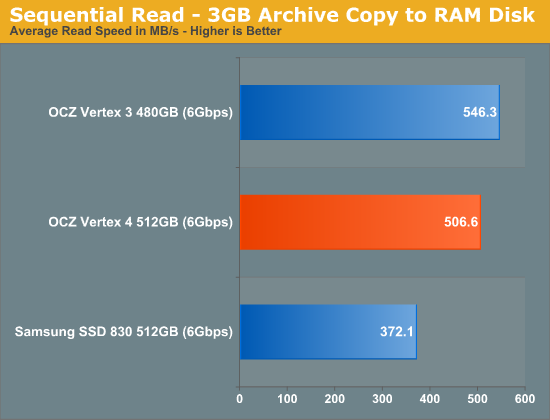
Clearly the Vertex 4 is capable of reading at very high rates – particularly when it matters, however the current firmware doesn't seem tuned for any sort of low queue depth operation.
Both of these issues are apparently being worked on at the time of publication and should be rolled into the next firmware release for the drive (due out sometime in late April). Again, OCZ's aim was to deliver a high-end drive that could be offered as an alternative to the Vertex 3 as quickly as possible.
Update: Many have been reporting that the Vertex 4's performance is dependent on having an active partition on the drive due to its NCQ streaming support. While this is true, it's not the reason you'll see gains in synthetic tests like Iometer. If you don't fill the drive with valid data before conducting read tests, the Vertex 4 returns lower performance numbers. Running Iometer on a live partition requires that the drive is first filled with data before the benchmark runs, similar to what we do for our Iometer read tests anyway. The chart below shows the difference in performance between running an Iometer sequential read test on a physical disk (no partition), an NTFS partition on the same drive and finally the physical disk after all LBAs have been written to:
Notice how the NTFS and RAW+precondition lines are identical, it's because the reason for the performance gain here isn't NCQ streaming but rather the presence of valid data that you're reading back. Most SSDs tend to give unrealistically high performance numbers if you read from them immediately following a secure erase so we always precondition our drives before running Iometer. The Vertex 4 just happens to do the opposite, but this has no bearing on real world performance as you'll always be reading actual files in actual use.
Despite the shortcomings with low queue depth sequential read performance, the Vertex 4 dominated our sequential write tests, even at low queue depths. Only the Samsung SSD 830 is able to compete:
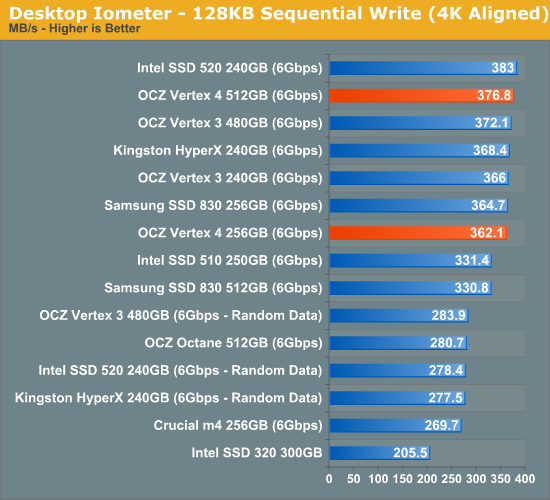
Technically the SF-2281 drives equal the Vertex 4's performance, but that's only with highly compressible data. Large sequential writes are very often composed of already compressed data, which makes the real world performance advantage of the Vertex 4 tangible.
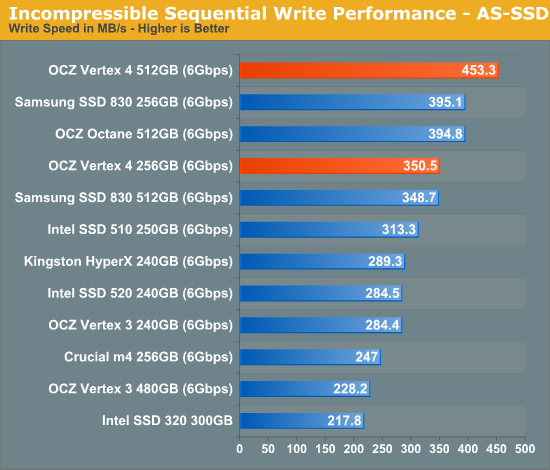
AS-SSD gives us another taste of the performance of incompressible data, which again is very good on the Vertex 4. As far as writes are concerned, there's really no beating the Vertex 4.


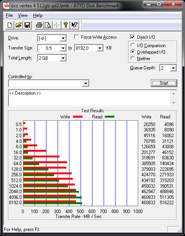
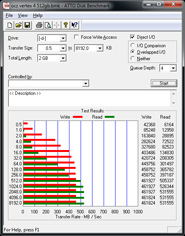

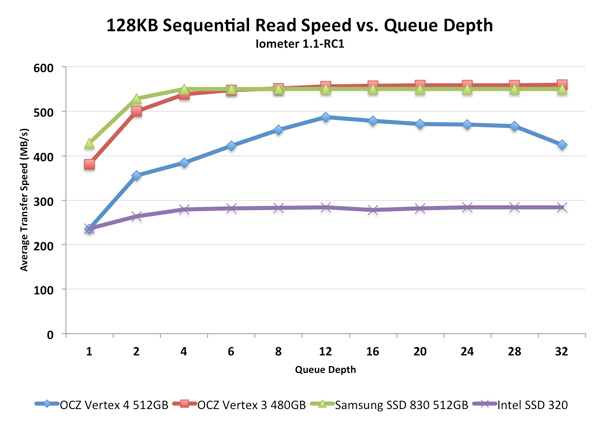
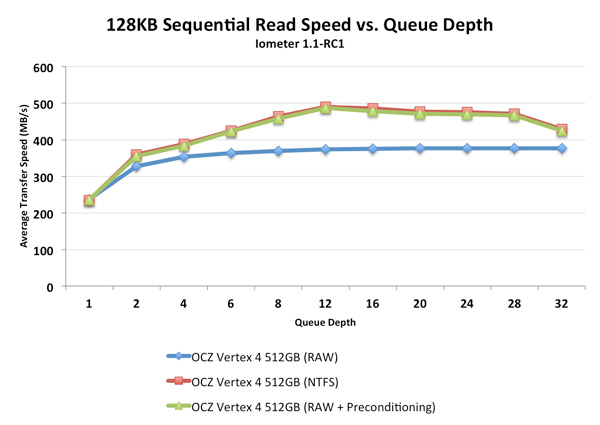








127 Comments
View All Comments
gigahertz20 - Friday, June 29, 2012 - link
Yes, I would like to see if the newer firmware has fixed this as well as OCZ promised. I wish they would create an update for this review.yj100 - Monday, July 9, 2012 - link
I got a Vertex 4 512gb a week ago for my MacBook Pro and after 2 days it crashed. Only a gray screen with a spinning wheel would come up when trying to boot.Apparently this is common as OCZ have a forum thread dedicated to this. Apparently they have a firmware fix but it didn't help me.
I have a 256gb Vertex 4 for about a couple of months with no problems. For 512gb I'm going to stay away from the Vertex 4.
Zarathustra[h] - Wednesday, July 25, 2012 - link
As some other sites have tested, it seems like the Vertex 4 is a completely different drive with the newer 1.4 firmware, and 1.5 added even more performance.Has Anandtech considered revisiting this drive with a later firmware? I have much more faith in Anandtechs reviews on SSD's than others and would love to see this drive tested with the latest firmware.
Zoeff - Sunday, July 29, 2012 - link
I second this.The heavy/light storage bench is unique to Anandtech and feels much more representative of actual usage.
Salv0 - Wednesday, August 1, 2012 - link
+1Retest with the latest fw will be great!
teefatt - Monday, September 3, 2012 - link
To potential OCZ SSD buyers,I posted the above matters to OCZ forum and got no solution from them after many email in and out in a week time. They want me to write an email to HP for help. They even deleted my reply and make the post like I did not reply their request or reply their mail. Furthermore, they blocked my post. They wanted me to send them a personal email instead of on the public forum.
They moved my post to ForumOCZ Support ForumCompliments, Complaints, & SuggestionsVertex 4 512GB BSOD in RAID 0 setup.
or
http://www.ocztechnologyforum.com/forum/showthread...
That's why I totally agree with the post here on the first page:
"It's still a drive from OCZ, a company that has repeatedly and blatantly used its customer base as unpaid beta testers, and lambasted them when they dared to complain about it. No thank you. The fastest drive in the world is of no use to me if it's causing my computer to BSOD constantly. I'll be spending my money and that of my many clients on drives with proven track records for reliability and excellent customer service, both sadly lacking in OCZ products."
I will walk away from this OCZ unreliable SSD. Luckily I am able to return the drives and asked for refund instead of following their steps to do the beta tester in a week time.
Think twice before you buy it.
Thanks you.
vwrafi - Saturday, September 29, 2012 - link
Hi. When the drive goes into the GC mode ( standard mode ), does it mean that the drive will start to read and write its internal data ? If so, does it mean that the write lifetime of the cells will reduce ( write lifetime of the disk will be reduced every time it reorganize itself ) ? And if so, can we switch off this or install firmware that do not shorten the write lifetime of the disk ?